Costa Rica 2016 Trip Report: First Impressions for Photography
Costa Rica is a diminutive country that has long been an established wildlife destination. Renowned for its remarkable biodiversity, well protected forests (one third of the land mass is national parks and private reserves), accessibility and high standards. Its proximity to the States has certainly been influential and it is already a very popular winter destination for those holding an Uncle Sam passport.
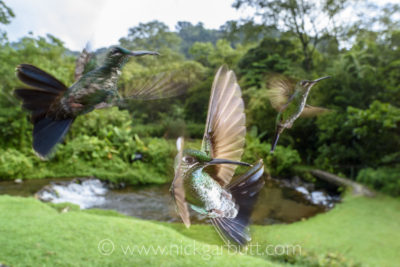
Green-crowned Brilliants, photographed with a wide angle lens at Bosque de Paz.
More than twenty years ago Costa Rica’s government invested heavily in controlled eco-tourism, rather than seeking to tap into the mass-market like many of its neighbours. The emphasis is on active adventure and appreciation of the natural world, with the involvement of local communities as much as possible.
Until recently all UK travellers had to fly via either Madrid or the States (e.g. Miami or Atlanta), which was obviously laborious. However, British Airways now offer a direct flight from London to San Jose that simplifies matters and speeds travel times up considerably. Consequently, I was given the opportunity to visit Costa Rica for the first time in August / September 2016.
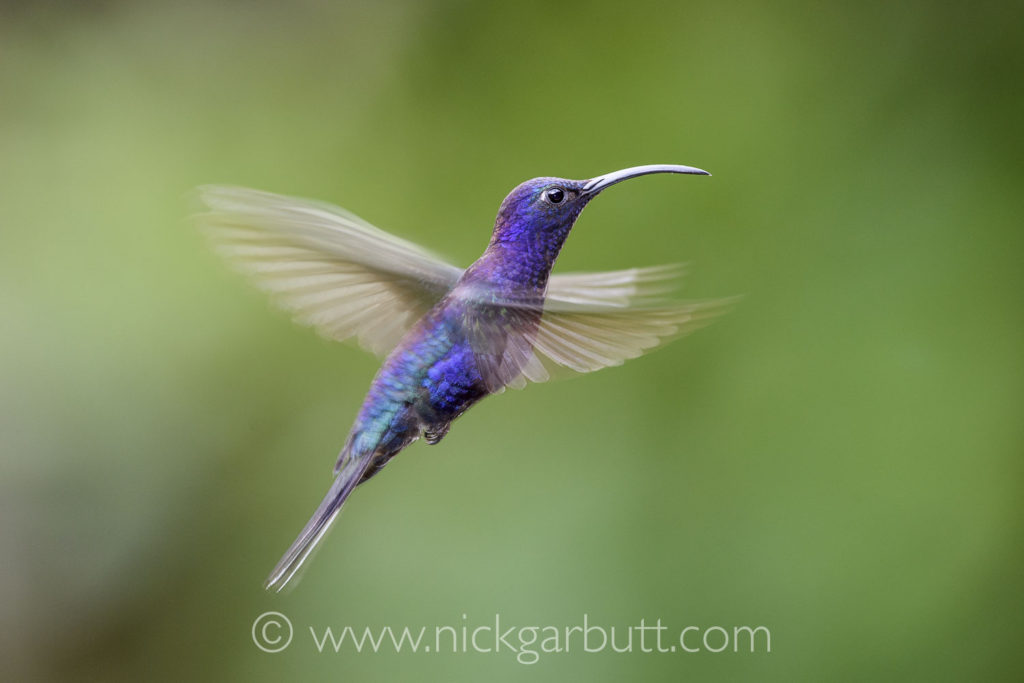
Male Violet Sabrewing at Bosque de Paz.
Given my love of tropical rainforest, it is perhaps surprising that I hadn’t visited the country before. I have been aware for at least 15 years how spectacular the wildlife can be, so I was full on anticipation and excitement when this chance came my way.
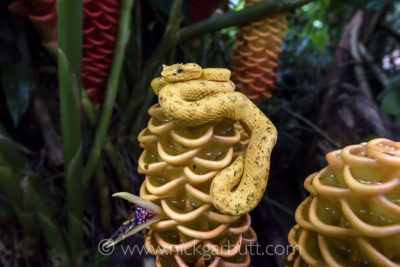
Eyelash Viper at Boca Topada: this is the distictive yellow / orange form known as 'oropel'.
The incredible diversity of wildlife in the country is a product of its position and topography. Costa Rica sits half way between the North and South American continents, helping connect these landmasses and funneling animal movements as they migrate north and south. In addition a central range of mountains forms a significant spine and elevation differences in habitat, thus creating distinct weather patterns on the western and eastern slopes, the former flowing to the Pacific Ocean, the latter to the Caribbean / Atlantic.
With this in mind, I was keen that my trip included important areas on both sides of the divide to gain an appreciation of as much of the diversity as possible. It is inevitable that a recce trip should end up as a ‘whistle-stop’ tour where only cursory visits to locations are possible. While this is far from ideal in many ways, as it is impossible to gain a genuine in-depth appreciation of any particular location, it does focus the mind and encouraged me to really focus on what the most important criteria and requirements would be when choosing locations that might be included in a future photography tour.
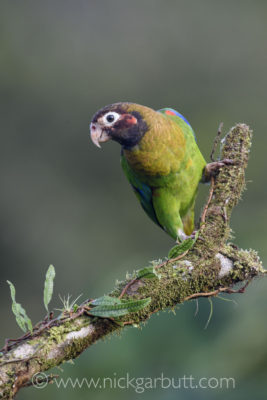
Brown-hooded Parrot in Boca Tapada: this bird was photographed at one of the lodge 'baited' sites.
In all I visited nine sites and locations in just thirteen days, staying no more than two nights in any single location. My main criteria when selecting locations to include on photography itineraries are three fold.
Firstly, there needs to be top-quality wildlife and wildlife watching. This can be either a broad diversity of species to see, or specific species that can be seen in exceptional ways. Secondly, the wildlife needs to offer excellent photography options and opportunities that are reasonably accessible and do not require complex logistics or equipment to achieve success. And thirdly, there needs to be decent quality and good value accommodation. I am not interested in expense and luxury for its own sake, but top dollar places might be considered if they offer something special and there is no cheaper way of achieving the same experiences.
With these criteria in mind, it was quickly clear that some locations did not fit the bill and would not be suitable for consideration. Several locations were very commercial and catered more for the mass-market side of adventure and wildlife tourism. These locations had to an extent lost the feeling of being ‘wild’ and tended more towards a contrived and manicured atmosphere. In addition some also were very regimented in the experience they offered, where flexibility away from the ‘standard package’ was difficult. Further, in some instances, this inflexibility extended specifically towards attitudes towards photography, where the use of flash was not allowed, which obviously made it impossible to take pictures of frogs and other nocturnal species after dark. For these reasons I was able to dismiss as options places like Arenal, Tirimbina, La Selva Biological Station and Selva Verde.
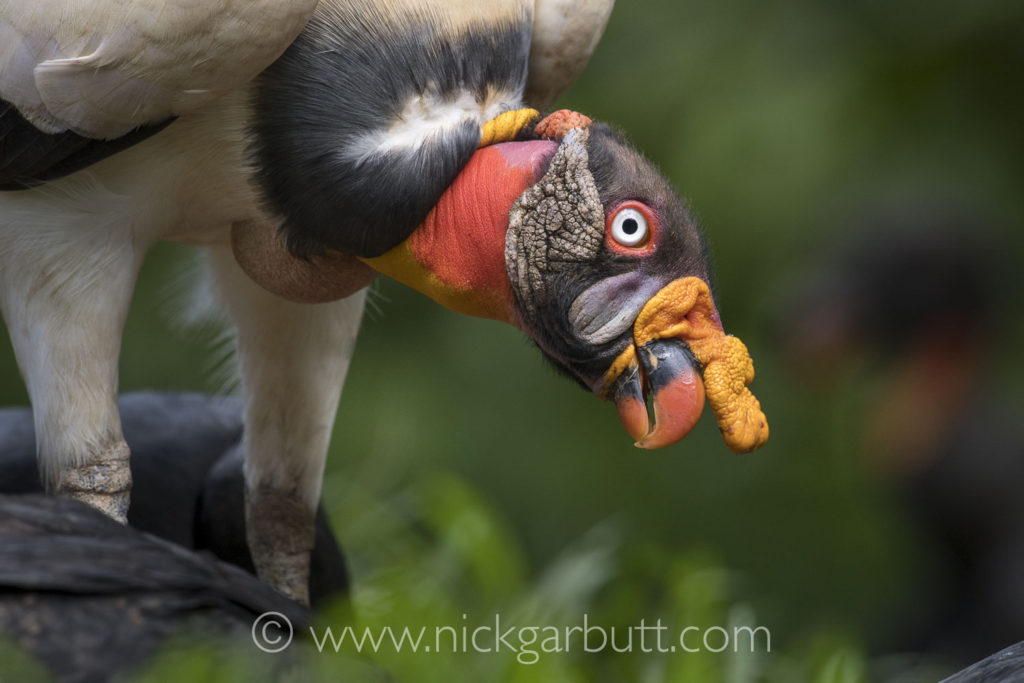
Adult King Vulture feeding in front of a purpose built photo hide.
These are the locations that most definitely offered something worthwhile for the wildlife photographer. At some the breadth of photographic opportunities was considerable and varied, at others it was more limited, but the opportunities were excellent.
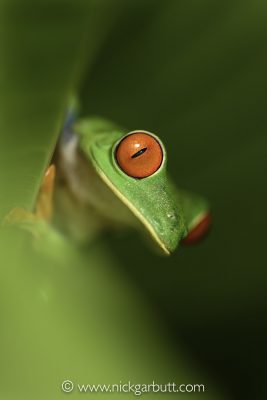
Red-eyed Tree Frog
Bosque de Paz
Located less than two hours from San Jose, this private montane forest reserve lies on the southern edge of Juan Castro Blanco National Park. During the day there is constant activity at the hummingbird feeders, which provide very good photo opportunities. The gardens attract other birds and wildlife like agoutis and pacas (after dark). There is an orchid garden and trails throughout the adjacent forest and along the streams offer the chance of good wildlife sightings especially for frogs.
Boca Tapada
Boca Tapada is situated near the San Carlos River in the north of Costa Rica, close to the border with Nicaragua. It is a remote location that boasts exceptional biodiversity. The Maquenque National Wildlife Refuge was created to preserve the habitat of the endangered great green macaw.
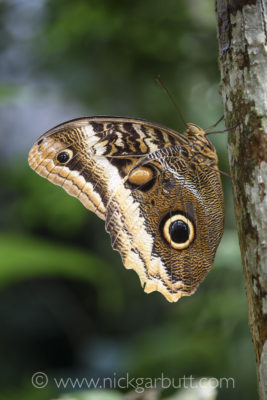
Owl-eye Butterfly shortly after emerging from its cocoon.
There are a number of lodges of varying standards that border and lie adjacent to the reserve. Many of these were formerly farms that have been allowed to revert back to forest. In a relatively short time the habitat has recovered to a remarkable degree and these forest areas are now alive with wildlife. The lodges have private area of secondary and primary rainforest, and in some instances these have been set up very much with photographers in mind.
During the day on forests walks it is possible to see and possibly photograph numerous birds, several species of primate and poison dart frogs, snakes and other reptiles plus wonderful invertebrates like owl-eye and Morpho butterflies. Night walks in these forests offer excellent opportunities to see and photograph various frog species, including the iconic red-eyed tree frog.
Around the lodges and in adjoining gardens there are plenty of birds and in some instances these are baited into appropriate perches for photography. These staged photo set-ups are effectively glorified bird tables, but that allow excellent completely wild looking images to be achieved.
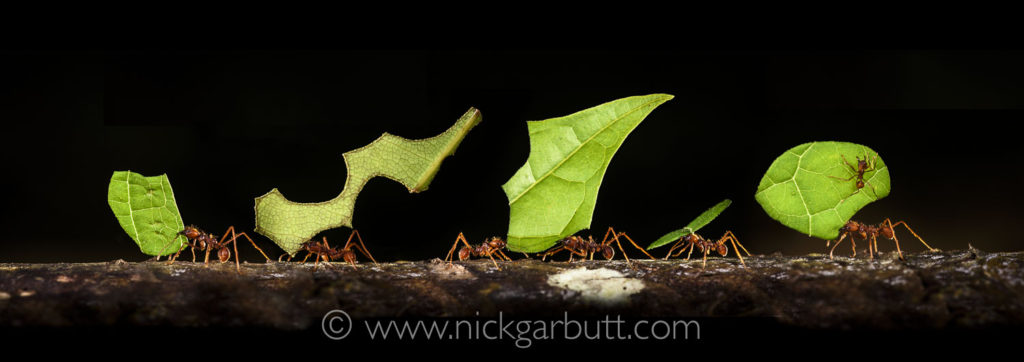
Leaf-cutter Ants are widespread in many rainforest areas.
Some lodges also have hides and other staged set-ups specifically built for bird and other types of photography. In addition there are sometimes also hummingbird feeders. One aspect that deviated from my experiences elsewhere was that in some instances lodges charged extra fees (at times considerable) to use these various hides and staged photography options. This modus operandi is certainly rather different to the rainforest lodges and locations I have visited in other parts of the world, where no such charges are levied.
Rancho Naturalista
Located at higher elevations on the Caribbean slope, this is primarily a bird watching lodge set amidst a private reserve of montane forest. Several species of hummingbird, most notably the snowcap, as well as many other birds, can be seen. Around the lodge balcony there are numerous hummingbird feeders that attract several of the commoner species, although the set up is not ideal for photography and improvements could certainly be made in this regard. There is also a moth / insect trap light, which attracts a wide selection of invertebrates each night (and several species of birds then feed avidly on the haul at dawn).
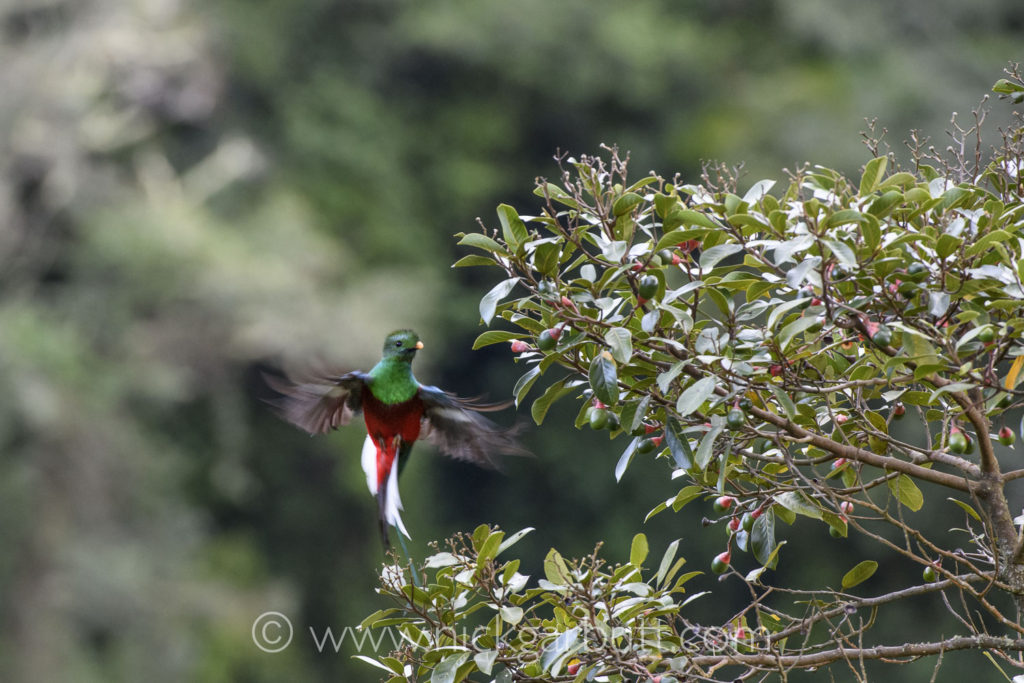
Male Resplendent Quetzal flying into a wild avocado tree.
San Gerardo de Dota
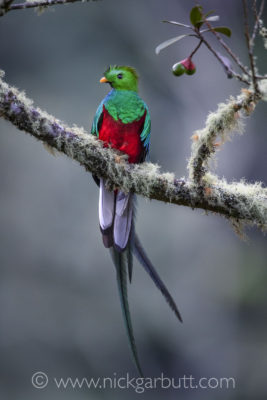
Male Resplendent Quetzal in the Savegre Valley.
The resplendent quetzal is arguably Costa Rica’s most iconic bird (although it is actually the national bird of neighbouring Guatemala). The cloud forest of Monteverde is perhaps the most famous place in Costa Rica to see them, but this location can be unreliable. Less famous but more reliable is the region of San Gerardo de Dota and specifically the Savegre valley. This steep-sided valley is at elevations between 2800m and 2000m, where high-altitude montane forest or cloud forest is dominated by tropical oak species. Crucially trees from the Lauraceae family, otherwise known as wild avocados, are plentiful as this is main food for the quetzals, as well as other species like emerald toucanet and collared trogon.
There is a choice of lodges, some higher up the valley, others lower down and in all cases bird life, especially hummingbirds, is visible. The adjacent forests certainly provide other photography opportunities.
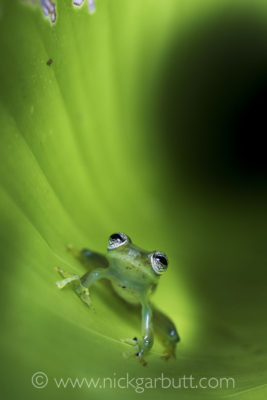
Montane Glass Frog inside curled leaf.
Without doubt the major attraction is the resplendent quetzal and there are early morning trips to look for and photograph the quetzals, which come to feed in wild avocado trees. Which trees are being used at any particular time varies, but the feeding trees (or nests at the right time of year) are generally well known.
No flash photography is allowed so early in the morning when light levels are especially low it is necessary to use high ISO values (ISO 3000 and above) in order to gain sharp images. As the light improves, then this can be lowered accordingly. The quetzals normally stop feeding and move into shaded areas as soon as the direct sun rises high enough to strike the trees in which they are feeding.
Osa Peninsula
Situated in the far south on the Pacific coast, the Osa Peninsula is one of the largest wilderness areas in Costa Rica. Roughly half the area of the peninsula constitutes Corcovado National Park. There is a dearth of suitable accommodation within the park itself and much of it remains too remote to access easily. However, outside the park there are numerous lodges with private areas of rainforest that support much the same diversity of wildlife as Corvovado itself.
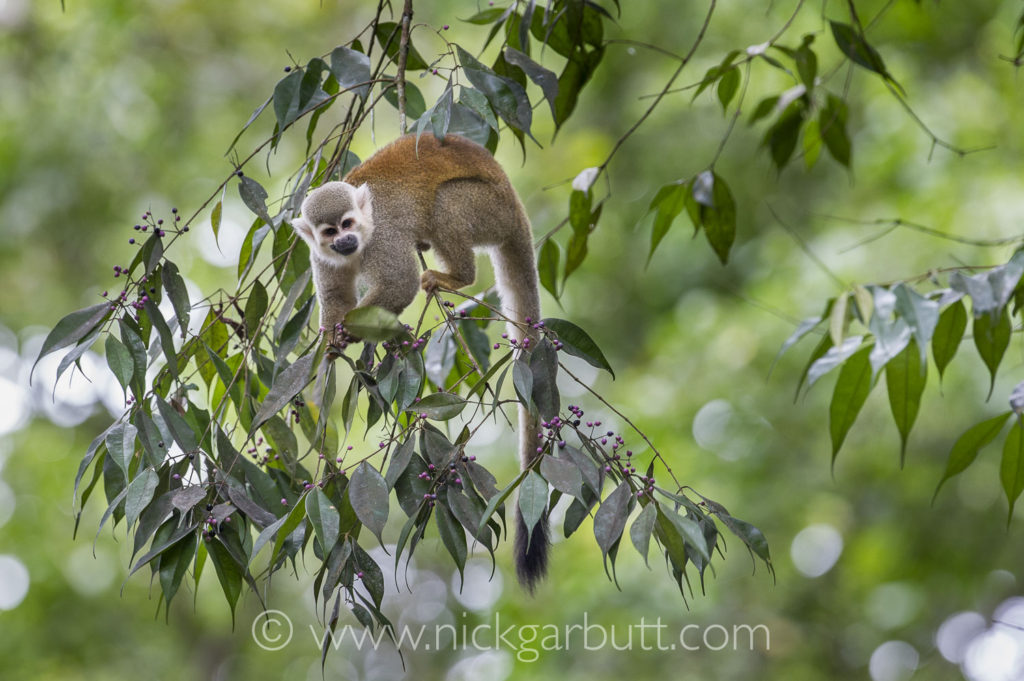
Squirrel Monkey
I stayed at a lovely lodge called Bosque del Cabo at the far south of the peninsula that borders both the Pacific Ocean and the Golfo Dulce. The lodge has gardens that attract wildlife and extensive rainforest areas that are diverse and very easily accessible. Spider monkeys, howlers and squirrel monkeys are generally easily seen, while coatis and agoutis live in and around the gardens. There are plenty of frogs (including poison dart frogs and red-eyed tree frogs) and reptiles and invertebrates to find and photograph. The forest reserve also has pumas, ocelots and even jaguars that are seen very occasionally.
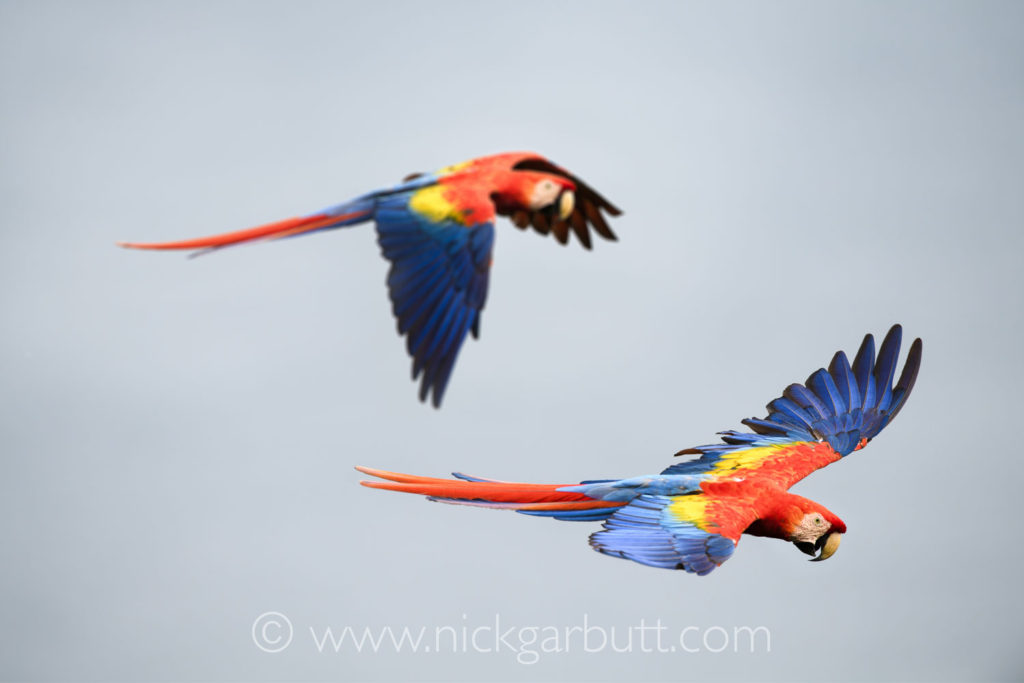
Scarlet Macaws in flight at Bosque del Cabo.
The lodge does not have any feeders, but the bird life is diverse and in many instances easy to see. There are plenty of toucans and scarlet macaws are easily seen and also provide excellent opportunities to photograph them in flight as they move between roosting and feeding areas, often flying by near eye level.
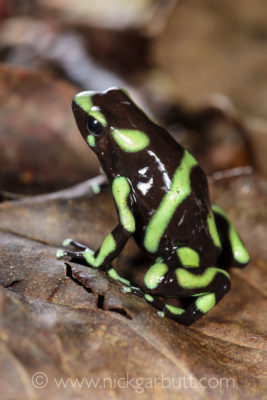
Green-and-Black Poison Dart Frog on rainforest floor.
Conclusions
I am sure there are many alternative areas in Costa Rica that I was unable to visit that would provide excellent options for photographers. For instance Tortugero National Park on the Caribbean coast and the dry forest areas around the Nicoya Peninsula. Also there are certain to be alternative lodges in the same or similar areas to those I visited that have something to offer.
However, from my experiences at the places I have mentioned I am very confident an excellent tour offering considerable diversity and photographic possibilities is achievable. I will continue to refine my thoughts with the intention of offering a dedicated photographic tour to Costa Rica sometime during the first half of 2019. I appreciate this is still quite some time away, but if you would like to register interest and put your name down to receive details once available, then please - click here.
